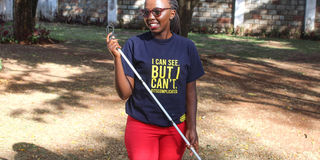People think I can see but I can’t, and it’s frustrating

What you need to know:
- When she was diagnosed with a rare eye disorder, 28-year-old Nancy Chelangat felt like her life was over.
- Chelangat slid into depression because it was hard to see and most people did not understand the condition .
When she was diagnosed with a rare eye disorder, 28-year-old Nancy Chelangat felt like her life was over.
Chelangat slid into depression because it was hard to see and most people did not understand the condition .
“Although I use a walking cane, sometimes I bump into people or objects on the streets due to low vision,” says Chelangat, who lives in Eldoret.
She has struggled with low vision since her childhood without knowing. “I used to be clumsy. I never participated in sporting activities for long and nobody knew why until I was diagnosed with the condition,” she says.
In 2013, her family sought medical help and a doctor recommended spectacles.
Even though she got the glasses, her eyesight deteriorated. She also acquired a foldable walking stick.
“The doctor said that it was short-sightedness. The condition became worse and I developed night blindness. I could not see even inside a dimly-lit room. I also bumped into people and objects, resulting in body injuries,” recalls Chelangat, who graduated with a degree in Public Relations and Communications from Kenya Methodist University in 2018.
In 2015, she sought a second opinion and was diagnosed with Retinitis Pigmentosa (RP), a rare eye disorder. RP is a genetic eye disorder that damages the retina – the light-sensitive tissue in the back of the eye.
The diagnosis weighed down on her. “I was frustrated and stressed. I had constant headaches because I was sensitive to light. The period between December and April 2015 was my toughest due to intense sunlight and heat that caused a strain on my eyes,” she says.
In 2016 she was diagnosed with macular edema, one of the manageable secondary diseases associated with the disorder. It is the build-up of fluid in the macula, an area in the centre of the retina or inflammation of the retina. Initially, she was given capsules and eye droplets to manage the edema, but the condition deteriorated.
Doctors recommended painful eye or intraocular injection in three-month intervals (initially) and six-month intervals later to lower the inflammation. “I have tunnel vision, which means that I can see straight ahead but not the sides. At the moment, I cannot see more than two objects. I can only see a person’s face,” Chelangat tells HealthyNation.
However, she is coping better after rehabilitation.
“I wanted to interact with people going through the same problem and prepare myself for life with the condition. I have accepted the condition and I want people to know they should not pity us but allow us to work. All we ask for is support when we face challenges,” says Chelagat.
Although there is scarce data on the condition, it is generally estimated the disorder affects every one in 4,000 people globally, according to US National Eye Institute.
“Currently, there is no definitive cure or treatment for the condition, but there is hope for a cure in the future with genetic treatment, where the genes are manipulated,” says Dr James Bett, head of Ophthalmology Unit at Moi Teaching and Referral Hospital (MTRH).
He says most hospitals in the country lack enough retina surgeons, making it hard for patients to access treatment.
“There are two diagnostic examinations for the condition through visual field testing for primary diagnosis and electroretinogram machine tests the retina cell activity, which is available in Nairobi. At MTRH, we do not have the electroretinogram machine,” he adds.
Retinitis Pigmentosa awareness month is marked in February.
“There are a few specialists in MTRH, Sabatia Eye Hospital and Tenwek Mission Hospital,” says Dr Bett.



